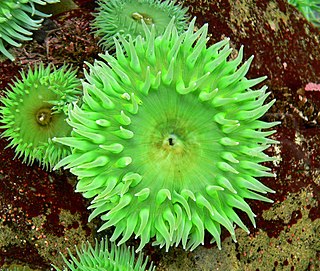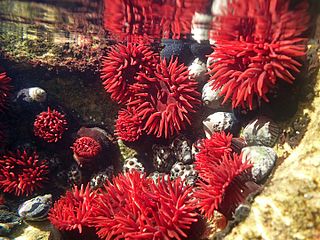
The starburst anemone or sunburst anemone is a species of sea anemone in the family Actiniidae. The sunburst anemone was formerly considered the solitary form of the common aggregating anemone, but was identified as a separate species in 2000.

Anthopleura xanthogrammica, or the giant green anemone, is a species of intertidal sea anemone of the family Actiniidae.

Phymanthus crucifer, commonly known as rock flower anemone, flower anemone, red beaded anemone or the beaded anemone, is a species of sea anemone in the family Phymanthidae. It has been described as "closely similar" to Heteractis aurora in several ways, commonly exhibiting "tentacles with swollen cross-bars" bearing large clusters of stinging nematocysts. However, P. crucifer may also be found with smooth tentacles, sometimes in the immediate vicinity of a swollen-crossbarred specimen.
Clinus brevicristatus, the Cape klipfish, is a species of clinid that occurs in subtropical waters of the Atlantic Ocean around South Africa where it prefers habitats with plentiful growth of seaweed. This species can reach a maximum length of 12 centimetres (4.7 in) TL.

Actinia tenebrosa, commonly named Waratah anemone, is the most common species of sea anemone found in the waters of eastern Australia and New Zealand. It is found relatively high on the seashore, in rock pools, and various cracks and shaded surfaces such as under rock overhangs in the intertidal zone.

Epiactis prolifera, the brooding, proliferating or small green anemone, is a species of marine invertebrate in the family Actiniidae. It is found in the north-eastern Pacific. It has a feature rare among animals in that all individuals start life as females but develop testes later in their lives to become hermaphrodites.

Sagartia troglodytes is a species of sea anemone in the family Sagartiidae, also known as the mud sagartia or the cave-dwelling anemone.

Metridium senile, or frilled anemone, is a species of sea anemone in the family Metridiidae. As a member of the genus Metridium, it is a type of plumose anemone and is found in the seas off north-western Europe and both the east and west coasts of North America.
Peachia cylindrica is a large species of sea anemone in the family Haloclavidae. It is normally found burrowed into soft substrates, the only visible part of the animal being the oral disc and tentacles which usually lie flat on the sand. It is the type species of the genus Peachia.

Heteractis malu, also known as the malu anemone, delicate sea anemone or white sand anemone, is a species of sea anemone in the family Stichodactylidae.

Macrodactyla doreensis, common names long tentacle anemone and corkscrew tentacle sea anemone, is a species of sea anemone in the family Actiniidae.

Condylactis aurantiaca, commonly known as the golden anemone, is a species of sea anemone in the family Actiniidae. This species always remains largely buried in sand or sediment, attached to the substrate, with only the oral disc and tentacles visible.
Anthopleura thallia, commonly known as the glaucous pimplet, is a species of sea anemone in the family Actiniidae. It is found in shallow water in the northeastern Atlantic Ocean and the Mediterranean Sea.

Aulactinia veratra, the green snakelock anemone, is a species of sea anemone in the family Actiniidae. It is native to the southeastern Indian Ocean and the southwestern Pacific Ocean.
Epiactis lisbethae, commonly known as Lisbeth's brooding anemone, is a species of sea anemone in the family Actiniidae. It is similar in appearance to the common brooding anemone, and like it is native to shallow waters on the western coast of North America.

Oulactis magna, commonly known as the giant shore anemone or camouflaged anemone, and by its Māori name kōtore tino nui, is a common sea anemone found in New Zealand.

Anthopleura rosea, commonly known as the rose anemone or rock pool anemone, is a small pink anemone endemic to New Zealand.

Bunodosoma californicum is a species of sea anemone. It was first described to science by Oskar Carlgren in 1951. The type specimen that Carlgren used to describe the species was collected by Ed Ricketts in Puerto Escondido during his trip to the Gulf of California with John Steinbeck recounted in The Log From the Sea of Cortez.

Anthopleura artemisia is a species of sea anemone. It is known by a number of common names, including burrowing anemone and moonglow anemone. It was first described to science in 1846 in a volume by James Dwight Dana, reporting on the animals found on the United States Exploring Expedition. Dana attributes the description to Charles Pickering, who was a naturalist on the expedition.

Actinostella flosculifera, the collared sand anemone, is a species of sea anemone in the family Actiniidae. It is found semi-immersed in the sediment in shallow water in the tropical and subtropical Atlantic Ocean.

















